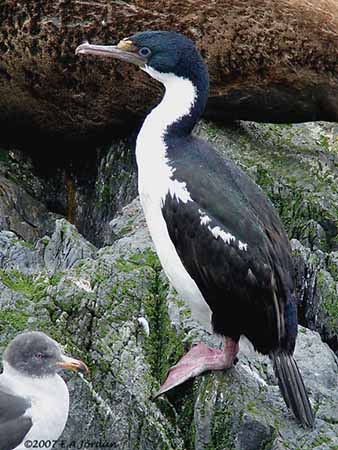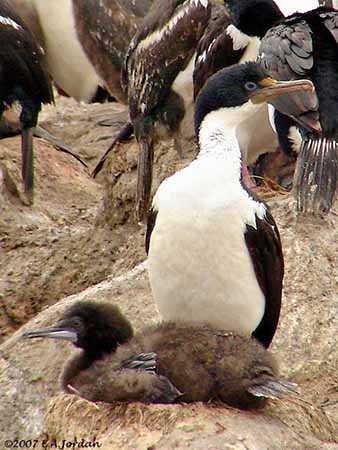
Fr: Cormoran imperial
All: Blauaugenscharbe
Esp: Cormorán Imperial
Ita: Cormorano imperiale
Nd: Keizeraalscholver
Sd: Kejsarskarv
Photographers:
Eduardo Andrés Jordan
MIS AVES – AVES DE ARGENTINA
Tom Merigan
Tom Merigan’s Photo Galleries
Otto Plantema
Trips around the world
Text by Nicole Bouglouan
Sources:
HANDBOOK OF THE BIRDS OF THE WORLD vol 1 by Josep del Hoyo-Andrew Elliot-Jordi Sargatal - Lynx Edicions - ISBN: 8487334105
BirdLife International (BirdLife International)
PCO’s Projects, Activities & Services
Wikipedia, la enciclopedia libre
Imperial Shag ou King Cormorant
Leucocarbo atriceps
Suliformes Order – Phalacrocoracidae Family
INTRODUCTION:
The Imperial Shag is a species of sub Antarctic and Antarctic waters, often seen foraging around islands or along the coast.
Unlike the cormorants of temperate and tropical areas, the Imperial Shag does not dry its wings by spreading them after diving. This is an adaptation to the extremely cold climate, in order to avoid the heat loss that this posture implies.
DESCRIPTION OF THE BIRD:
Biometrics:
Length: 68-76 cm
Wingspan: 124 cm
The adult of nominate race (not displayed here) has large white dorsal patch and conspicuous white wingbars. The upperparts are glossy black whereas the underparts are white.
On the head, forecrown, crown and nape are black, with blue gloss on the crown. There is a tuft of black feathers on the forehead. We can see conspicuous ochre to dusky caruncles at base of upper mandible. The bare facial skin is blackish, with prominent bright blue eyering.
The bill is greyish to blackish. The eyes are dark brown. Legs and webbed feet are pink.

The non-breeding adult lacks the white wingbar, the crest and the dorsal patch.
Both sexes are similar.
The juvenile resembles non-breeding adult, but it has duller and browner upperparts. It lacks crest and caruncles, and has paler bill and gular pouch.
SUBSPECIES AND RANGE:
L.a. atriceps (here described) occurs in southern South America, on the southern coasts of Chile and Argentina.
L.a. albiventer (here displayed) is found on Falkland Islands, and locally in southern Argentina and Chile.
This one is very similar to nominate, but it lacks the white dorsal patch, making the upperparts uniformly glossy black. On the head, the black starts beside the gape and moves straight backwards. It may have sometimes a small reddish spot between the eye and the caruncles. In breeding plumage, the caruncles are very conspicuous, bright orange-yellow. The blue eyering can be brighter than on nominate.

HABITAT:
The Imperial Shag breeds along the coasts, or sometimes on islands, in freshwater coastal lagoons. But it feeds exclusively at sea. They usually forage in these areas, along the coasts and around the islands.
They form large colonies, often mixed with penguins and albatrosses. They nest on cliffs and on rocky islands.
They may be found locally in large inland lakes in foothills of Andes, up to 800 metres of elevation were they breed on rocky islets.
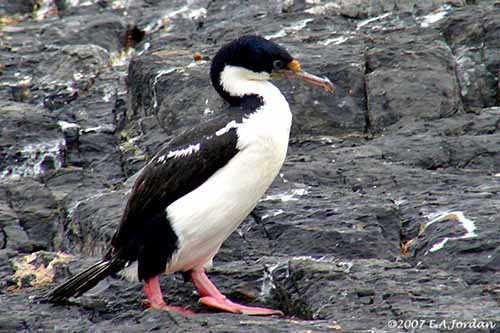
CALLS AND SONGS: SOUNDS BY XENO-CANTO
The Imperial Shag male gives several barking, rasping, nasal “aark”, and other sounds such as croaking, gargling and groaning calls.
The female produces softer sounds, hissing or puffing sounds, but she is often silent.
The typical calls are used in courtship displays or uttered in threat and alarm situations.
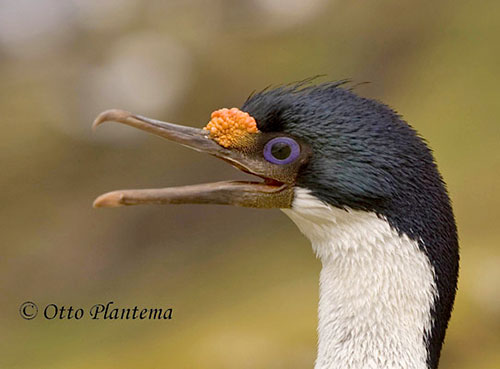
BEHAVIOUR IN THE WILD:
The Imperial Shag feeds mainly on fish and crustaceans (Munida gregaria in Falklands), amphipods and cephalopods. But the diet varies according to the location of the colonies.
It feeds by pursuit-diving and is able to dive as deep as 50 metres to catch a prey under rocks or in kelp beds. It can forage during two bouts of 30 minutes, before to return to land in order to dry its plumage.
At sea, they can form large feeding flocks. They are opportunistic forages, and can exploit diverse preys around the site of the colony.
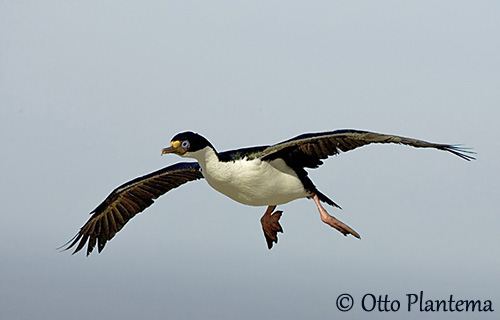
The Imperial Shag breeds in large colonies of hundreds or thousands of birds. Competition between pairs for best locations is always fierce, and aggressive territorial encounters often occur, with threatening displays and postures, fighting with bill-grapping, or one bird seizing the other by the neck or the wings.
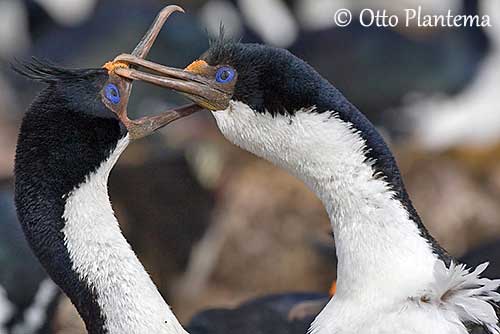
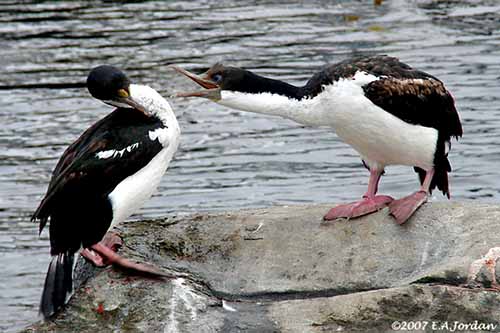
The male usually displays from the nest-site. The “wing-waving” with lifting of the wing tips enhance the white wingbars. The bill is pointed upwards and forwards to expose the bright coloured patterns of face and eyes.
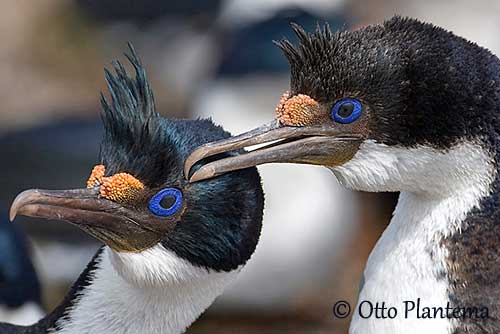
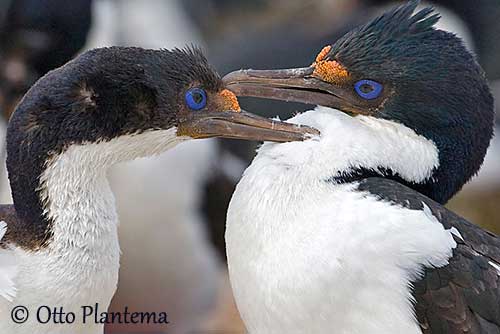
These displays end when a female lands beside the male and is accepted. The male performs “greeting-displays”, often repeated through the breeding cycle.
Then, the male starts collecting nest materials and the female arranges them in the nest. Copulation usually takes place at the nest-site. The pair defends a small area around the site. Fights occur mainly between males.
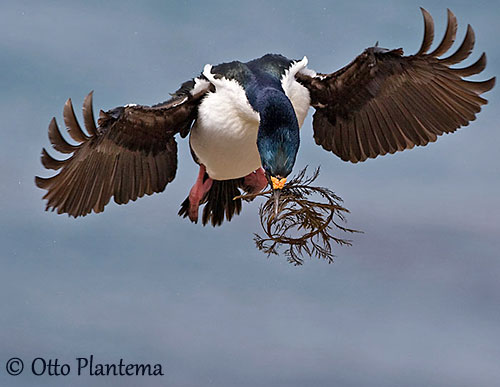
The Imperial Shag is basically sedentary, but numerous birds wander up coasts of Chile and Argentina, to north of breeding areas.
During the austral winter, they often move up Atlantic coast, as far as Uruguay. The Falklands’ birds remain around the islands all year round.
The flight is powerful, with regular wingbeats sometimes interspersed with occasional glides. They may reach speeds of up to 80 km/hour.
REPRODUCTION OF THIS SPECIES:
The breeding season starts in October/November.
The Imperial Shag forms colonies that can be very large, often shared with other seabirds and penguins.
The nest is placed on flat top of rock, or on islets in sea or on lakes. This is a truncated cone made with seaweed and various plant materials, cemented together with mud and excreta. The nest-site is often reused year after year.
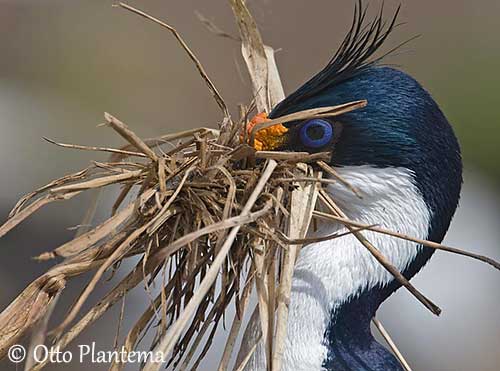
The female lays 2-4 eggs. Both adults take turns and share the incubation during about 28 days. At hatching, the chicks are naked and helpless. They grow quickly while they are fed on regurgitated fish by both parents. They fledge 75-80 days after hatching, and are usually able to fly. But if not, they gather at sea in small crèches until they become independent.
PROTECTION / THREATS / STATUS:
Chicks and eggs are taken by skuas and sheathbills, and the populations are vulnerable to pollution and natural events such as storms. Some populations are decreasing, others are fluctuating or stable. They are estimated at 340000/1400000 mature individuals.
The Falklands’ population is estimated at about 60 000 breeding pairs, but it has shown significant decline over the recent years.
But currently, the Imperial Shag is evaluated as Least Concern and not globally threatened.
